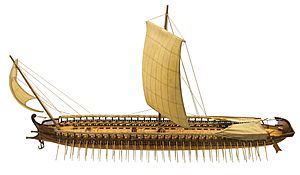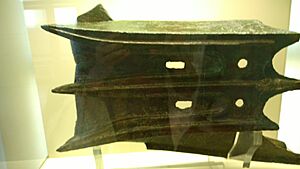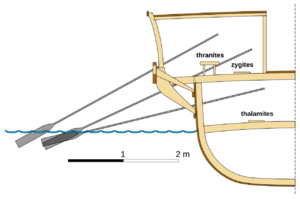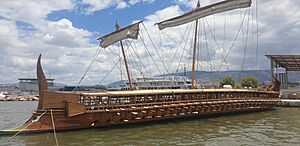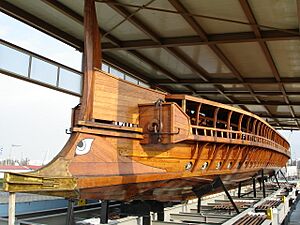Trireme facts for kids
A trireme (say: TRY-reem) was an ancient ship used by civilizations around the Mediterranean Sea, like the Phoenicians, ancient Greeks, and Romans. Its name comes from its three rows of oars, with one person rowing each oar.
The trireme was a faster and more agile warship. It was the most important warship in the Mediterranean from the 700s BC to the 300s BC. Later, bigger ships like the quadriremes and quinqueremes took its place. Triremes were very important in the Persian Wars. They also helped Athens build its powerful sea empire.
Contents
History of Triremes
Where Did Triremes Come From?
Pictures from the 8th century BC show ships with two rows of oars. These were called biremes. Around the same time, we find the first mentions of ships with three rows of oars.
Experts are not sure if the trireme was invented in Greece or Phoenicia. Some ancient writers said the Phoenicians from Sidon invented it. Others, like Thucydides, said the Corinthians brought the trireme to Greece in the late 8th century BC.
Early Use and Development
The first clear record of triremes being used in a sea battle is around 525 BC. This was when Polycrates, a ruler from Samos, sent 40 triremes to help the Persians invade Egypt.
By the early 400s BC, the trireme became the main warship in the eastern Mediterranean. Greek and Phoenician triremes were similar. The first big sea battle with triremes was the Battle of Lade. Here, the Persian fleet defeated the Greek cities of Ionia.
Triremes in the Persian Wars
Athens was fighting the island of Aegina, which had a strong navy. To fight Aegina and prepare for the Persians, the Athenian leader Themistocles convinced the people to build 200 triremes. They used money from new silver mines.
The first big fight with the Persian navy was at the Battle of Artemisium. Both sides lost many ships. But the most important sea battle was at Salamis. Here, the Persian invasion fleet was completely defeated.
After these victories, Athens became very powerful. Its strong fleet of over 200 triremes controlled the Aegean Sea. This fleet also protected trade routes and food shipments. The fleet gave jobs to many poorer citizens. This helped keep Athens' democracy strong.
Triremes in the Peloponnesian War
In the Peloponnesian War, sea battles with triremes were key. Athens fought against Sparta. Even though there were many land battles, Athens lost when its fleet was destroyed. This happened during the Sicilian Expedition and finally at the Battle of Aegospotami.
Trireme Design
The design of the trireme was very advanced for its time. Builders had to think about many things. These included how many rowers it could hold, how it would move, its weight, and how stable it would be. All these parts worked together perfectly.
The trireme had three rows of oarsmen on each side. They were packed closely but could still work. The lowest row of oarsmen were called thalamios. The middle row were zygios, and the top row were thranites. The ship's design kept its center of gravity low. This made the ship very stable in the water.
Triremes needed a lot of care. Ropes, sails, rudders, oars, and masts often needed replacing. If left in the sea too long, they would soak up water. To stop this, ships had to be pulled out of the water each night. This was possible because they were made of light wood. About 140 men could carry a ship ashore.
The Athenian trireme had strong cables called hypozomata. These cables ran along the middle of the hull. They helped keep the ship from bending or breaking apart. These cables were so important that taking them out of Athens was a crime punished by death. They also helped the ship survive ramming attacks in battle.
Size of a Trireme
We know about the size of Athenian triremes from old ship sheds found in Piraeus, Athens' main war harbor. These sheds were about 40 meters (131 feet) long and 6 meters (20 feet) wide. This means a trireme was just under 37 meters (121 feet) long.
The ship's hull was about 2.15 meters (7 feet) above the water. It had a shallow bottom, only about 1 meter (3 feet) deep. This shallow depth and light weight made it easy to pull the ship onto the beach.
How Triremes Were Built
Building a trireme was very expensive. It took about 6,000 days of work to finish one. Ancient shipbuilders built the outer hull first, then added the inner ribs. Cables were used to make the hull stronger.
The wood used was very important. Fir, pine, and cedar were common. Pine was strong but heavy. Fir was lighter. Oak was used for the hull to make it tough for beaching. The wood for the joints had to absorb water to swell and make the hull watertight.
Triremes were often decorated. They had painted eyes, nameplates, and figureheads. These decorations showed the owner's wealth and aimed to scare enemies. Wealthy citizens often paid for triremes. They competed to make the most impressive ship.
How Triremes Moved
The main way the ship moved was from its 170 oars. These oars were in three rows, with one person per oar. The ship also had two masts with square sails. Two steering oars at the back helped guide the ship.
Triremes could travel at about 6 knots (11 km/h or 7 mph) for a long time. Some records suggest they could go even faster. A modern replica, the Olympias, reached 8 knots (15 km/h or 9 mph). It could also turn 180 degrees in just one minute.
A trireme could cover about 80-100 kilometers (50-62 miles) in a good day. Sometimes, with experienced crews, they could go almost twice that distance. Commanders had to make sure their rowers did not get too tired before a battle.
Trireme Crew
A trireme usually had about 200 people on board. This included 170 rowers, the deck crew, and a small group of soldiers.
The Captain
In Athens, the ship's captain was called the trierarch. This was a wealthy citizen who was in charge of getting the ship ready and keeping it maintained. It was a big financial cost, but it also brought great respect.
Deck Crew
The deck crew was led by the kybernētēs, the helmsman. He was an experienced sailor and often the ship's commander. Other officers included the bow lookout, the boatswain, and the shipwright. A piper played music to help the rowers keep their rhythm.
Rowers
The rowers in ancient navies were free men, not slaves. In Athens, rowing was a key part of military service for the lower classes. Sometimes, foreigners were also hired.
Athenian rowers practiced a lot. This made them skilled professionals. The rowers were divided into three groups based on their position:
- 62 thranitai in the top row. They rowed through an outrigger that allowed the third row of oars.
- 54 zygitai in the middle row.
- 54 thalamitai in the lowest row. Their spot was the most uncomfortable.
Most rowers could not see the water. So, they needed great skill to row together. They likely used hand signals and pipe music to coordinate.
Marines
Triremes carried a small number of soldiers called marines (epibatai). Usually, there were 10 to 20 of them. They were used for boarding enemy ships. At the Battle of Salamis, Athenian ships had 14 soldiers and 4 archers.
Marines were important for defending the rowers. If an enemy ship boarded, the marines protected the crew below deck. They would also throw stones at other ships in calm waters.
Battle Tactics
Ancient sea battles used two main methods: boarding and ramming.
- Boarding: Ships would pull alongside an enemy ship. They would try to break its oars to stop it from moving. Then, soldiers would jump onto the enemy ship and fight hand-to-hand.
- Ramming: Triremes had a strong ram at the front. This ram was used to smash holes in the enemy ship's hull. The best way to ram was from behind. The Athenians were very good at ramming.
Before a battle, the masts and railings of the ship were taken down. This made it harder for enemies to use grappling hooks.
Fleets of triremes used different tactics:
- The periplous involved sailing around the enemy to attack them from behind.
- The diekplous was a strong charge to break through the enemy line. Ships would then turn and attack from behind.
- The kyklos (circle) was a defensive tactic. Ships formed a circle to protect themselves.
Athens was strong because of its navy. Sparta was strong because of its land army. But Sparta realized it needed a navy to defeat Athens. With help from Persia, Sparta built new fleets. Sparta eventually destroyed the Athenian fleet at the Battle of Aegospotami.
Spartans often focused on ramming Athenian triremes head-on. Athenians used speed and skill to ram enemy ships from the side.
Battle Casualties
In sea battles, many men died by drowning. When a trireme was rammed, panic would make it hard for men below deck to escape. Bad weather made survival even harder. For example, after a battle off Cape Athos, only 12 out of 10,000 men were saved.
If men did not drown, they might be captured. Sometimes, captured crews were killed or had their right hand cut off so they could never row again. Pictures show prisoners being thrown into the sea.
Sea battles were often watched by thousands of people on shore. They were more dramatic than land battles. In a sea battle, an entire fleet could be lost. At the Battle of Arginusae, 263 ships and 55,000 men were involved. At the Battle of Aegospotami, Athens lost 170 ships and most of its sailors were killed or captured.
Changes in Trireme Use
Over time, bigger warships replaced the light trireme in powerful navies. These new ships had more rowers per section, not more rows of oars. This was because ships started to have more armor to protect against ramming. Heavier ships were needed for successful attacks. These new ships also allowed less trained people to row them.
Triremes were still used by smaller navies. They were also used by empires like Syracuse, Carthage, and later Rome. These later triremes had more armor and carried more soldiers. Lighter versions of triremes were also used as support ships. They were still very effective because they were easy to move.
When Rome became powerful, it controlled the Mediterranean. There was less need for a huge navy, as the main enemy was pirates. Roman fleets used lighter triremes, but they still carried many soldiers. From this type of ship, the dromon later developed.
Reconstructing a Trireme
From 1985 to 1987, a shipbuilder in Piraeus, Greece, built a replica of an ancient Athenian trireme. It was named Olympias. Experts used old evidence and underwater discoveries to build it.
In 1988, the Olympias was rowed by 170 volunteer oarsmen. It reached a speed of 9 knots (17 km/h or 10.5 mph). This showed that ancient writers were likely telling the truth about how fast these ships could go. The Olympias could also make a 180-degree turn in just one minute.
The builders learned that ancient triremes had rowers in a staggered position on three levels. This made the best use of the space inside the ship. Modern people are taller than ancient Greeks. So, the rowing conditions on the Olympias were a bit cramped for the modern crew. This might be why the ancient speed records are still unbroken.
Images for kids
See also
 In Spanish: Trirreme para niños
In Spanish: Trirreme para niños
- Warship
- Penteconter
- Bireme






